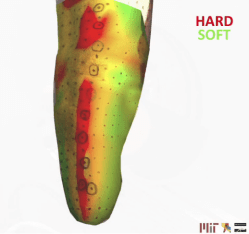Traditionally, sockets for prostheses are created by making a plaster cast of the limb being fitted, and are then sculpted in carbon fiber. It’s an expensive and time-consuming process, and what is supposed to be a customized socket often turns out to be an uncomfortable disappointment. Though prosthetists design these sockets specifically to take pressure off of the more rigid areas of tissue, this usually ends up putting more pressure on the softer areas, causing pain and discomfort.
 An MIT team led by [Arthur Preton] wants to make prosthesis sockets more comfortable and better customized. They created FitSocket, a machine that assesses the rigidity of limb tissue. You can see it in motion after the break.
An MIT team led by [Arthur Preton] wants to make prosthesis sockets more comfortable and better customized. They created FitSocket, a machine that assesses the rigidity of limb tissue. You can see it in motion after the break.
FitSocket is essentially a ring of 14 actuators that gently prod the limb and test how much pressure it takes to push in the tissue. By repeating this process over the entire limb, [Preton] can create a map that shows the varying degrees of stiffness or softness in the tissue.
We love to see advancements in prostheses. Here’s an electronic skin that brings feeling to artificial fingertips.
Thanks for the tip, [Aaron].

















How much does this thing cost, plus the cost for training staff? I can see this being used in the third world to make cheaper prosthetics, measure the patient, send off the measurements to China and Alibaba delivers the leg in a week.
This sounds like another “Engineer-Savior trap” to me.
I don’t see the issue. All it does is allow more customized prosthetics to be made, faster. It’s not like they’re trying to save the world with it.
So how do they use the data from this device to design better sockets? What adjustments are made?
I have one hand. I used prosthetics sometimes as a kid, but gave them up around 5th grade – they handicapped me.
There are two pains to having one hand: buying one glove (try it some time..) and hammer & punch/chisel.
(Nails are easy. I lost track after the first 200/300 pounds of nails.)
My solution is a “fuzzy stump”.
https://www.instructables.com/id/Fuzzy-Stump-Socket-Prosthetic/
I have a few prototypes in the post.
Total cost is under $20 – should be cheaper in quantity.
Minimal training needed.
This is in the public domain.
You can charge for materials, but don’t try to make a profit.
If you want to take it to the Third World (eg Africa, South America, Southeast Asia, etc) go for it.
Just post your travels in the comments section.
Just read through your whole link. Would it work to apply the sticky (or maybe even non-sticky) pile velcro strips before the resin strips cure? Let the resin do the work of holding them on (maybe even better than the adhesive alone could do?).
The resin sets up pretty quick. Plus applying the velcro take a while. So – interesting idea, but I don’t think it would work.
Very cool! Keep up the good work!
Wow, that’s some serious hacking. Good work! And that’s a great simple low-cost solution. I love the ingenuity of using Velcro like that, I imagine it’s much more flexible and quick to use when you’re doing stuff like woodwork.
I assume some people do like the expensive 3D printed stuff though, or there’d be no market for them?!
Well … My observation is the folks doing the 3d prints are f*kn do-gooders who want to “help the poor crippled children”. My perspective is they are really crippling the “poor children”. It’s the difference between a crutch and a tool. If you don’t need it, but you become dependent on it, it’s a crutch. A tool is something you use for a specific task.
I think the 3d print hand folks fear loss of a limb && thing they would be crippled if they suddenly had one hand.
Thinking about it longer, your solution excels for stuff like woodwork etc where you need to hold loads of parts/tools in awkward positions for short periods of time. And you’re willing to tolerate some discomfort to do so – holding stuff often isn’t comfortable with your hand – and perhaps sores etc perhaps aren’t such an issue as you’re only holding things for shorter periods?
Whereas something like a prosthetic leg/foot has very different requirements, and will benefit from the solution in the post, as it doesn’t need to be super-adaptable, but it does need to fit well, and not put pressure on the wrong places.
Well – I build houses for a hobby. The only thing I really need to hold that is tricky is a romex staple. Otherwise, I don’t need anything special.
I was married 2 weeks and broke my left knee. I can personally attest mobility is more important than dexterity. The biggest technical issues are the joints – ankles and knees. That is an appropriate use of such tech.
“Welcome to the Identity Processing Program of America.”
Very nice work.
Where can i have this done.
Why? Check out my fuzzy-stump link, above.
this is from years ago. is this a new step in the technology, or a repost reminder?
My name is spelled wrong. It should be “Arthur Petron.” Thanks.